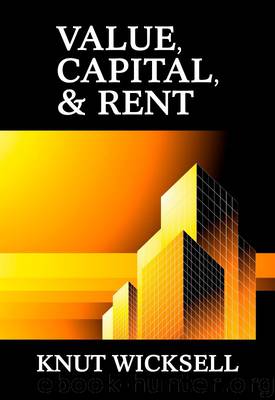Value, Capital & Rent by Knut Wicksell

Author:Knut Wicksell [Knut Wicksell]
Language: eng
Format: epub
ISBN: 978-1-61016-061-2
Publisher: Sentry Press
Published: 2007-11-06T16:00:00+00:00
no longer have any significance if they cannot be satisfied by a positive y and by an x which it at the same time positive and smaller than a. If p has already become to small that x, and consequently y alto, are zero, the above equations must, if p continues to decreases, be replaced by x = 0, y = 0; that is to say, the possessor in question no longer exchanges at all.
If, on the contrary, x becomes equal to a, ρ increasing, then the possessor will tell at this price his whole supply of (A). If the price is a little higher still, he will generally, even at this price, exchange hit whole supply, but not more, since he does not possess any more of (A). Our equations must then in the first instance give way to the more simple relationships x = a,y = pa.
If, moreover, we consider the discontinuities of the individual consumption and demand, x and y can by no means be regarded as continuous functions of p.
1 Strictly speaking, however, this is generally only the case when the commodities (A) and (B) cannot replace each other, so that, as we have assumed above, the marginal utility of one of them depends simply on the quantity owned of this commodity or on the quantity acquired, and not at the same time on the quantity acquired or the quantity owned of the other commodity. But if both commodities can replace each other completely or partly, it is a different matter. Suppose, for instance, that (B) is wheat and (A) potatoes. If a possessor of wheat can cover with it the whole of his annual food requirements, but potatoes are cheaper in proportion to their nutritive value, then he will probably exchange every year a certain quantity of wheat for the cheaper potatoes. But if now the price of potatoes (expressed in terms of wheat) were to fall still lower, he could first of all procure for himself the same quantity of potatoes in exchange for a smaller outlay of wheat. But since he thus keeps more wheat, his annual requirements in the matter of food could be even more than covered in this way. Therefore, if it is for him only a question of satisfying these requirements, he will be able to keep without loss a still greater quantity of wheat and content himself with a smaller quantity of potatoes, so that his demand for potatoes would finally decrease with the falling price instead of increasing.
1 Of the production of goods no account is taken here, of course.
2 For, in accordance with his assumptions repeatedly mentioned, a simple marginal utility function (in respect of each of the commodities) was drawn, identical for both parties. Here, of course, the curves can only have one single (real) point of intersection in common.
1 In this case, the curves of the commodity (B) also would, of course, intersect at three points, lying vertically under the points of intersection of the curves of commodity (A).
Download
This site does not store any files on its server. We only index and link to content provided by other sites. Please contact the content providers to delete copyright contents if any and email us, we'll remove relevant links or contents immediately.
| Analysis & Strategy | Bonds |
| Commodities | Derivatives |
| Futures | Introduction |
| Mutual Funds | Online Trading |
| Options | Portfolio Management |
| Real Estate | Stocks |
Rich Dad Poor Dad by Robert T. Kiyosaki(6414)
Pioneering Portfolio Management by David F. Swensen(6230)
How To Win Friends and Influence People by Dale Carnegie(4447)
The Money Culture by Michael Lewis(4083)
The Dhandho Investor by Mohnish Pabrai(3706)
The Wisdom of Finance by Mihir Desai(3659)
Liar's Poker by Michael Lewis(3372)
Fooled by Randomness: The Hidden Role of Chance in Life and in the Markets by Nassim Nicholas Taleb(3049)
The ONE Thing by Gary Keller(3010)
The Intelligent Investor by Benjamin Graham Jason Zweig(2995)
Mastering Bitcoin: Programming the Open Blockchain by Andreas M. Antonopoulos(2983)
Rich Dad Poor Dad: What The Rich Teach Their Kids About Money - That The Poor And Middle Class Do Not! by Robert T. Kiyosaki(2909)
How to Day Trade for a Living: Tools, Tactics, Money Management, Discipline and Trading Psychology by Andrew Aziz(2909)
Investing For Dummies by Eric Tyson(2894)
How to Win Friends and Influence People by Dale Carnegie(2863)
Market Wizards by Jack D. Schwager(2645)
The Psychology of Money by Morgan Housel(2633)
Zero Hour by Harry S. Dent Jr. & Andrew Pancholi(2614)
How to Pay Zero Taxes, 2018 by Jeff A. Schnepper(2604)
